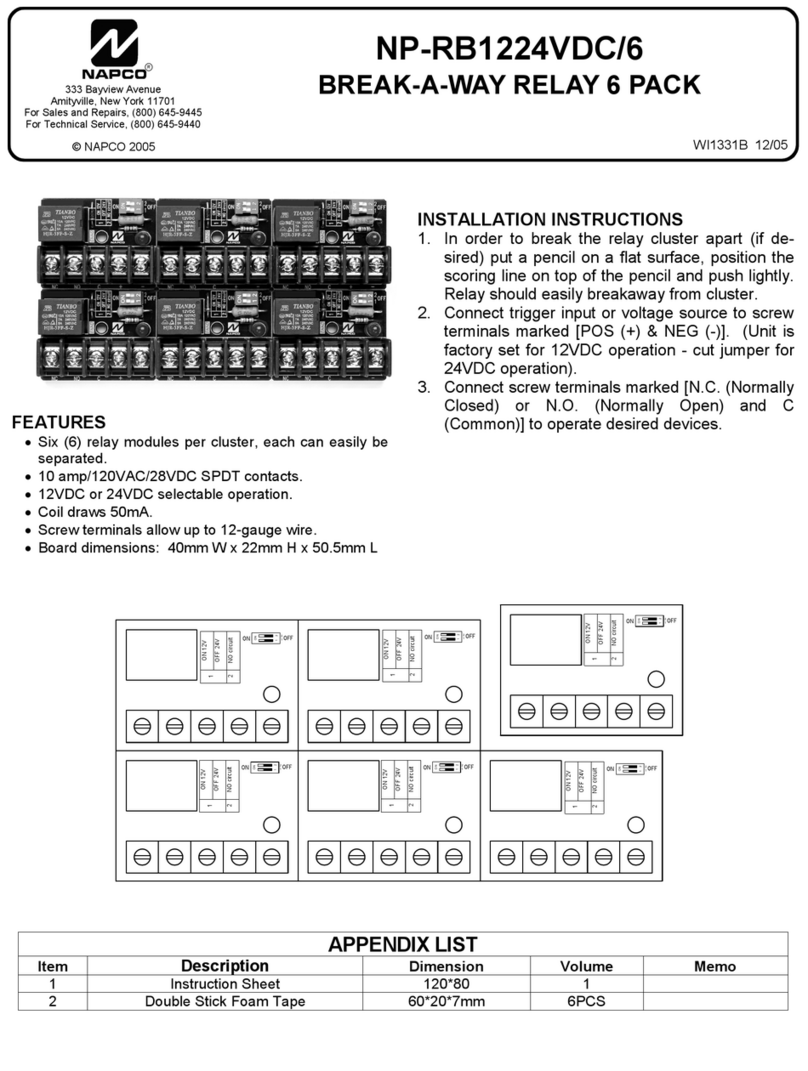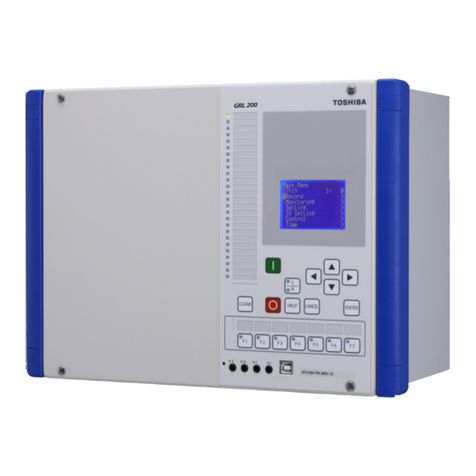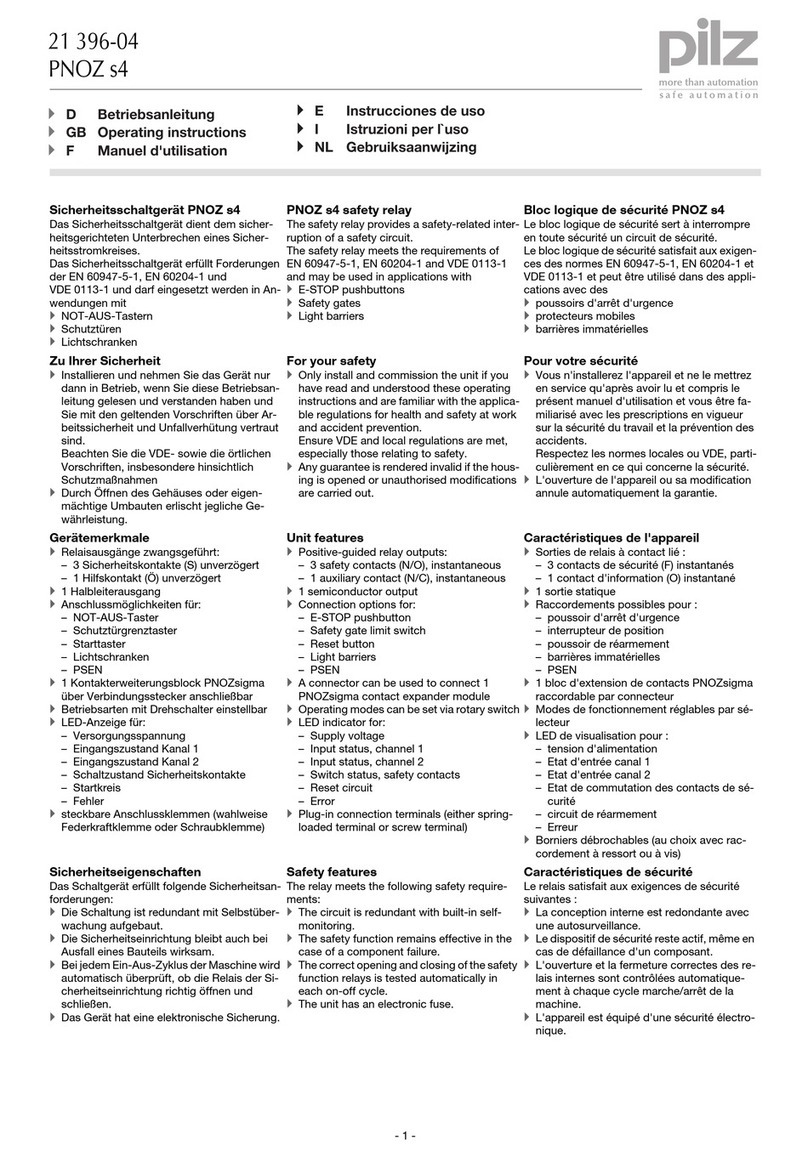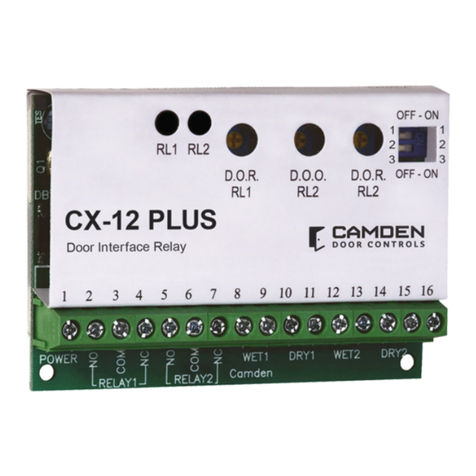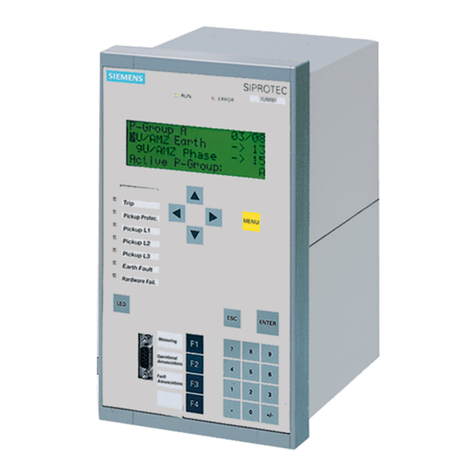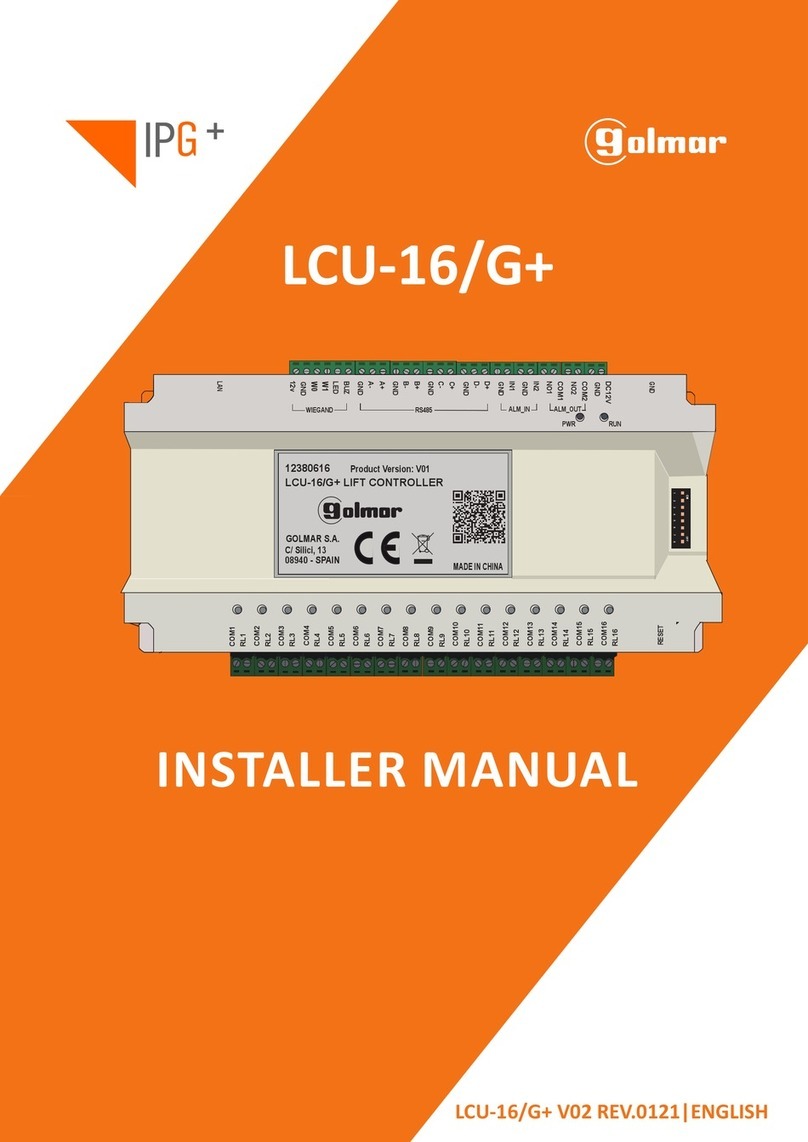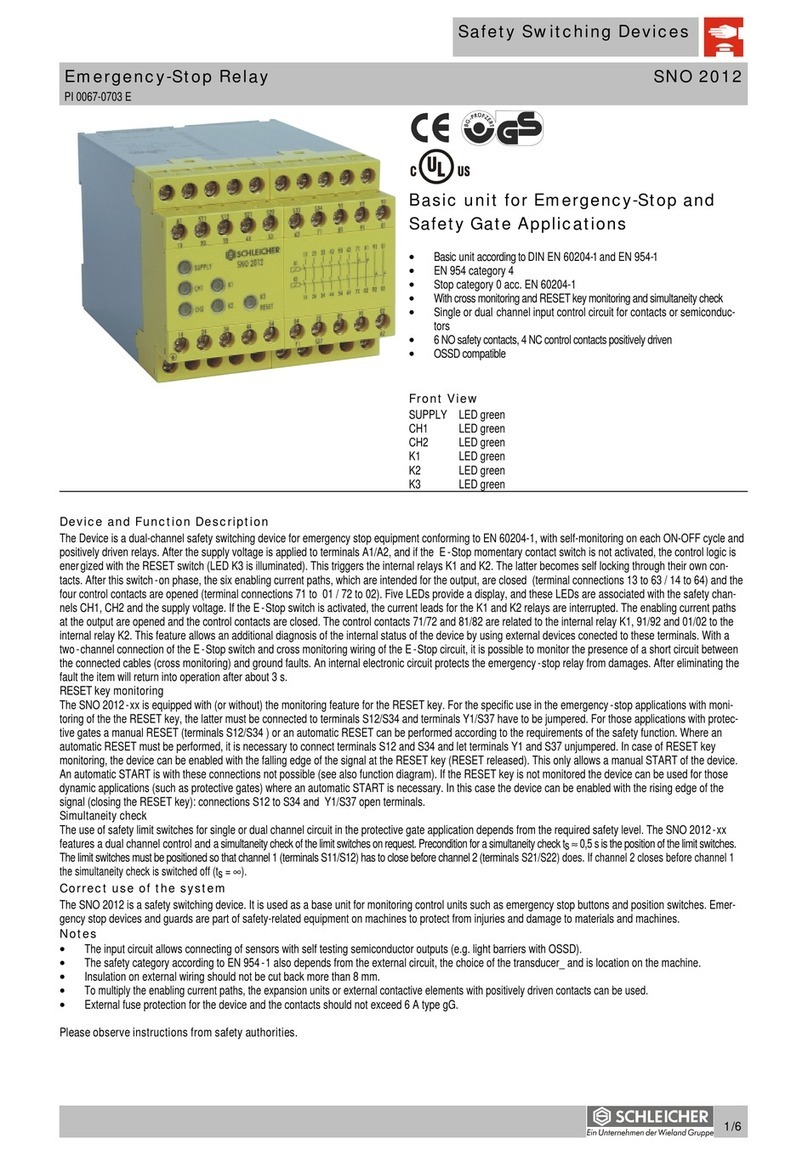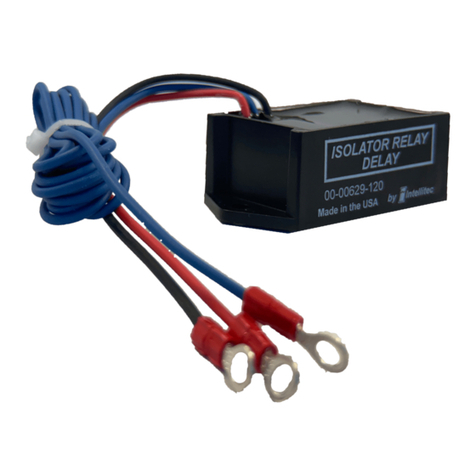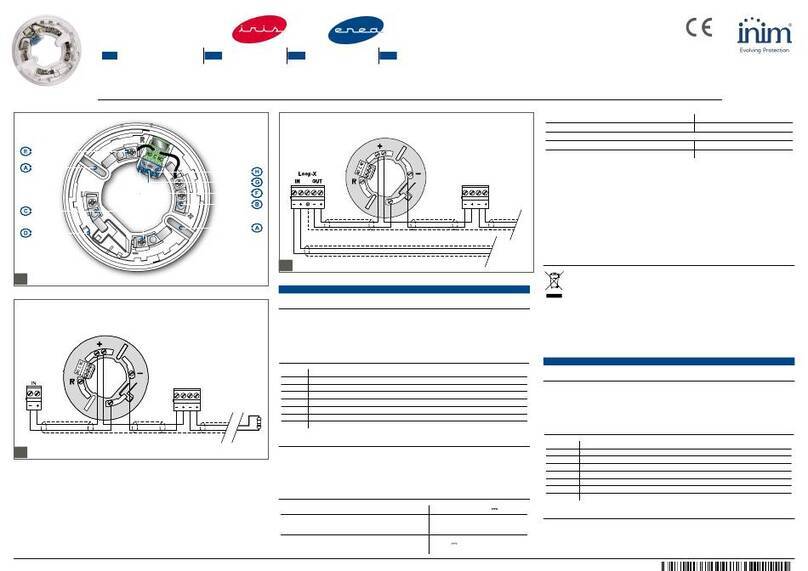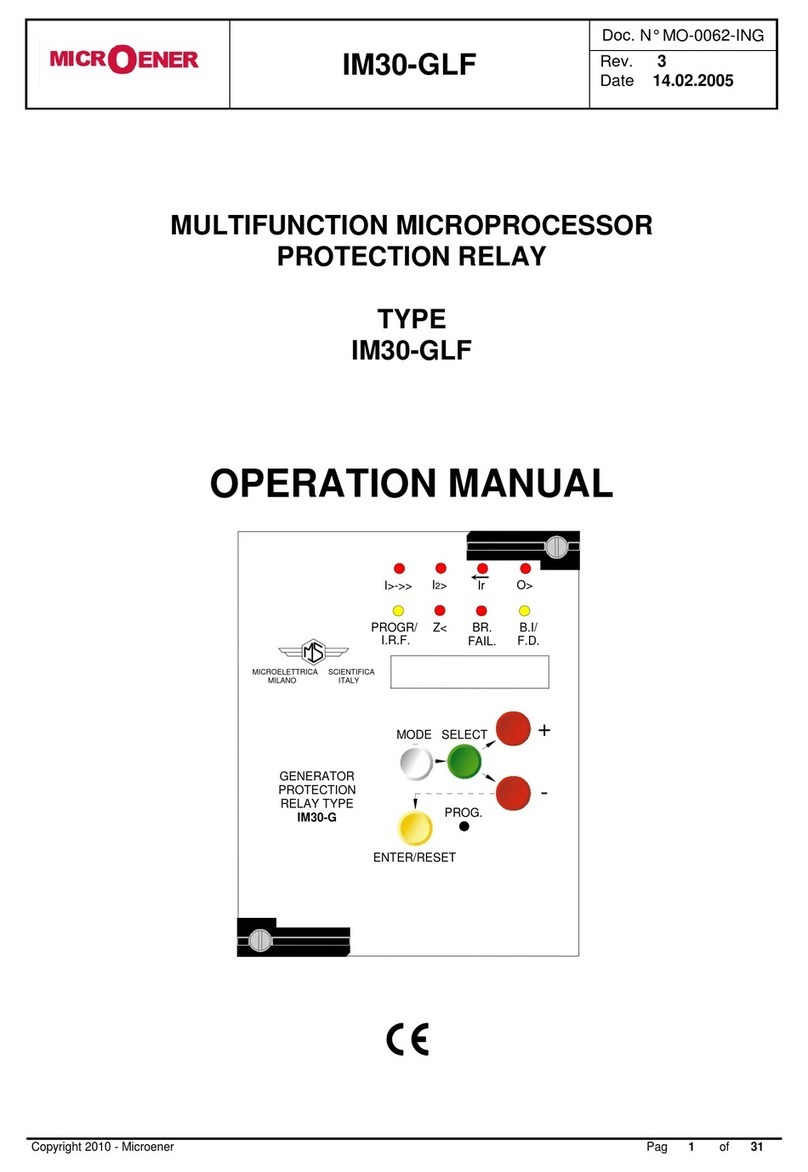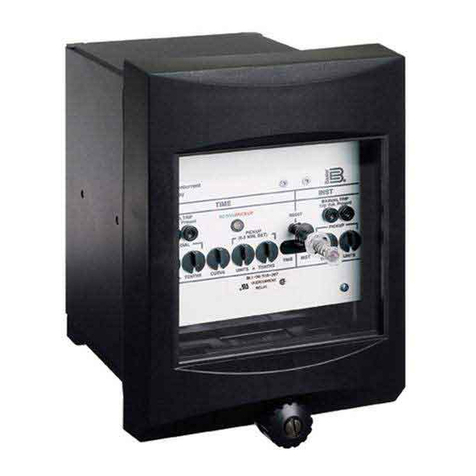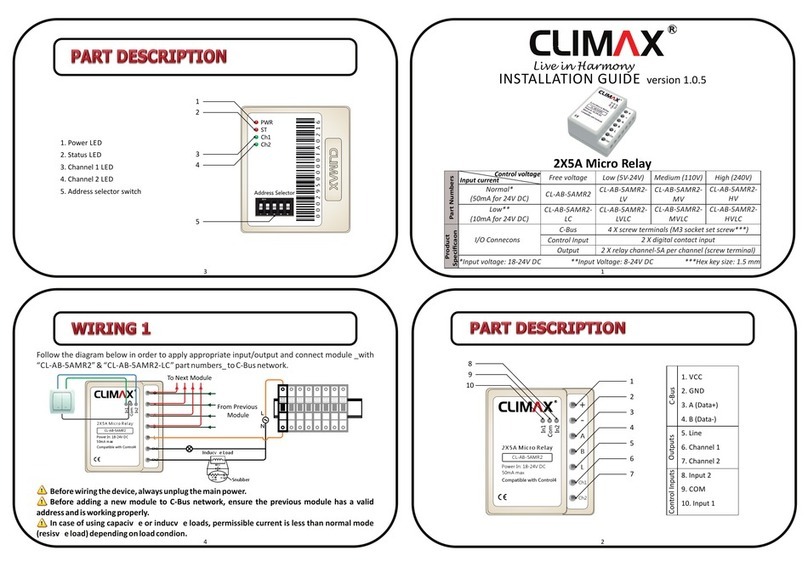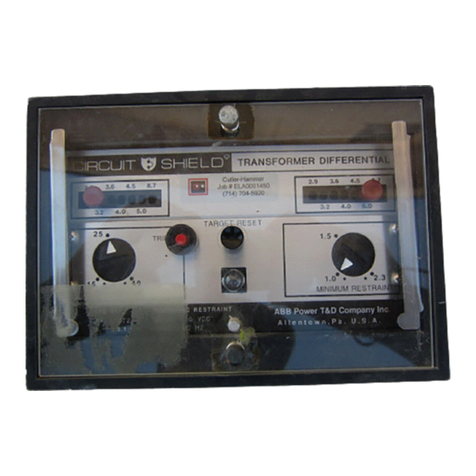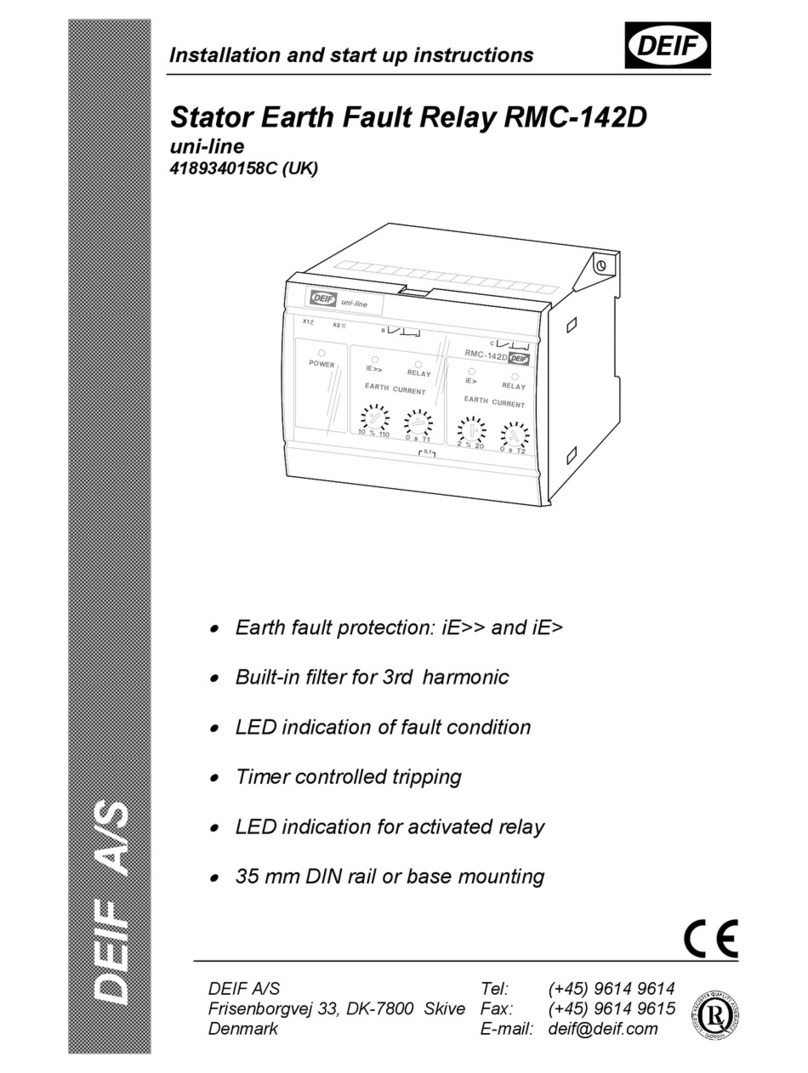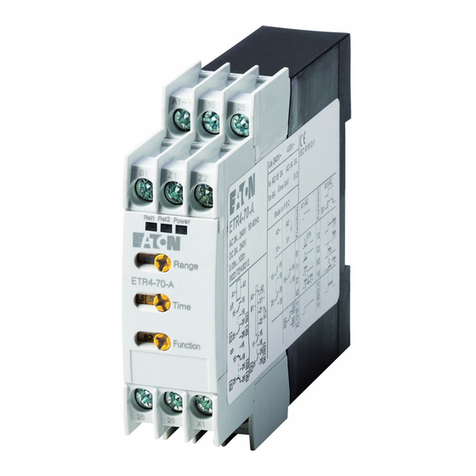I-Gard SIGMA-MD User manual

C-EG42EM Instruction Manual, December 2018
(Previously C-455EM)
GROUND FAULT RELAY
NEUTRAL GROUNDING RESISTOR
SIGMA-MD

1
SUBJECT PAGE
1. General Information....................................................................................................................3
2. Description..................................................................................................................................4
3. Method of Operation..................................................................................................................4
3.1 Components of the System....................................................................................4
3.2 Neutral Grounding Resistor Monitoring................................................................5
3.3 Ground Fault Detection...........................................................................................5
4. Installation Instructions..............................................................................................................6
4.1 The SIGMA-MD Monitor Relay...............................................................................6
4.2 Zero Sequence Current Sensor (ZSCS)................................................................7
4.3 Ngrs-XX Sensing Resistor......................................................................................8
4.4 Configuration of SIGMA-MD Monitor Relay and NGR .......................................8
5. Trip Relay and Auxiliary Fault Relay..........................................................................................9
6. Led Indicators and Diagnostics...............................................................................................10
6.1 Start-Up and Reset Indications..............................................................................10
6.2 Power on Led (Green)..............................................................................................11
6.3 Ground Fault Led (Red)...........................................................................................11
6.4 NGR Fault Led (Red)................................................................................................11
6.5 Zone Ground Led (Red)...........................................................................................12
7. Self-Test......................................................................................................................................12
8. Relay Settings............................................................................................................................13
8.1 Trip Relay Operating Modes....................................................................................13
8.2 Trip Memory Setting.................................................................................................14
8.3 Ground Fault Trip Time Delay..................................................................................14
8.4 Ground Fault Trip Current Level .............................................................................15
8.5 System Frequency....................................................................................................15
8.6 NGR Set Let-Through Current.................................................................................15
9. SIGMA-MD Monitor Relay Configuration Switches..............................................................15
10. Technical Specifications..........................................................................................................19
11. Catalogue Numbers.................................................................................................................22
Appendix A High-Pot and Dielectric Testing................................................................22
Appendix B CAN/CSA M421-00 Use Of Electricity In Mines (Excerpts)...................23
12. Applications Examples ...........................................................................................................23
TABLE OF CONTENTS

2
I-Gard’s commitment to electrical safety provides both industrial and commercial
customers with the products needed to protect their electrical equipment and the
people that operate them.
As the only electrical-safety focused company whose product portfolio includes
neutral grounding resistors, high-resistance grounding systems and optical arc
mitigation, we take pride in our technologies that reduce the frequency and
impact of electrical hazards, such as arc flash and ground faults.
For those customers who have purchased from us over the last 30 years, you
know us for the quality and robustness of our products, our focus on customer
service and technical leadership. We build on this foundation by investing
in developing new products in electrical safety education - including EFC
scholarship program - by actively participating in the IEEE community programs
on technical and electrical safety standard, and working with local universities
at discovering new technologies. We remain unrelenting in our goal of improving
electrical safety in the workplace.
Our commitment to excellence is validated by long-standing relationships with
industry leaders in fields as diverse as petroleum and gas, hospitals, automotive,
data centers, food processing, aerospace, water and waste water plants, and
telecommunications. We provide our customers with the product and application
support required to ensure that their electrical distribution system is safe and reliable.
ABOUT I-GARD

3
1. GENERAL INFORMATION
The I-Gard SIGMA-MD monitor relay is a combination neutral grounding resistor (NGR) monitor and ground fault
relay. In distribution systems employing high resistance grounding, the SIGMA-MD monitor relay protects against
ground faults and abnormal resistance values of the neutral grounding resistor (NGR).
The SIGMA-MD monitor relay is specifically designed for a variety of system voltages and a neutral grounding
resistor (NGR) limiting the maximum NGR current to the relay’s set let through current.
The SIGMA-MD monitor relay is designed to be used with a TxA type zero sequence current sensor, an NGRS-XX
resistor sensor and an NGR sized to limit ground fault current to that stated in the installation’s specifications.
The let-through current measured by the zero sequence current sensor will be the vector sum of any leakage
currents or charging currents normally in the system and any ground fault currents that may be present.
Hazard of Electrical Shock, Burn or Explosion
All installation, servicing and testing referred to in this manual must be
performed by qualified personnel. All power should be disconnected
prior to removing covers or enclosures and where live conductors
may otherwise be exposed.
Failure to observe these precautions may result in death or severe
personal injury and damage to equipment. Before placing an
intentional ground fault on the power system, check that a fault does
not already exist. Any test ground fault equipment must be rated for
full system voltage and be fused for protection.
DANGER
IMPORTANT
Each SIGMA-MD monitor relay and its auxiliary parts, is carefully inspected before being packed in specially
designed cartons. Any unit received should be examined immediately upon receipt. If damage or indication of rough
handling is apparent, a claim should be filed with the transport company immediately. I-Gard should be notified
promptly if replacements for damaged goods are necessary. If units received are not to be installed immediately
they should be stored in their original containers in an area free of dust and moisture.

4
2. DESCRIPTION
The SIGMA-MD monitor relay measures the current through the NGR, the transformer neutral-to-ground voltage and
the NGR resistance. The relay compares the measured values against the field settings of the relay and provides
relay outputs and LED indications when an abnormal condition is detected.
NGR current is measured using the zero sequence current sensor. The trip level of the ground fault circuit is DIP
switch selectable as a percentage of the NGR let-through current setting at 5%, 10%, 15%, 20%, 25%, 30%, 40%
and 50%. Trip time is DIP switch selectable from 60 milliseconds to 3.15 seconds.
Transformer neutral-to-ground voltage is measured by means of the NGRS-XX resistor sensor (NGRS), connected
between the NGR’s connection to the transformer neutral and the relay’s NGRS input terminal. The NGRS-XX
resistor sensor is used by the SIGMA-MD monitor relay as part of a comparator to monitor the NGR resistance. The
NGRS-XX resistor sensor contains a voltage suppressor which limits its output voltage to a safe level.
When the NGR current measured by the ZSCS is above 1% of the NGR let-through current setting, an NGR fault
will be detected if the measured current and voltage indicates that the NGR resistance has increased to more than
150% in the standard mode or 300% when the corresponding DIP switch is set for the extended tolerance mode, or
has decreased to less than 66% of its nominal value.
When the ZSCS current is below 1% of the NGR let-through current setting, the SIGMA- MD monitor relay simply
monitors the NGR resistance for continuity, i.e. whether the NGR is open or presents some resistance.
The SIGMA-MD monitor relay has four output relays:
• The trip relay can be programmed for shunt trip operation (non-failsafe) or undervoltage operation (failsafe) in a
main breaker trip circuit. The trip relay will operate on either an NGR fault or a ground fault.
• The NGR fault auxiliary trip relay can be used to give a door/panel mounted or remote indication of an NGR fault.
• The ground fault auxiliary trip relay can be used to give a door/panel mounted or remote indication of a ground fault.
• The SIGMA-MD Healthy state alarm relay.
The SIGMA-MD monitor relay provides a current source output for connection to a 1mA full scale ammeter (either
analog or digital). The output signal is proportional to the measured current and is expressed as a percentage of the
NGR let-through current.
3. METHOD OF OPERATION
3.1 COMPONENTS OF THE SYSTEM
The zero sequence current sensor is an I-GARD TxA type.
The NGRS-XX resistor sensor is selected to match the line-to-line voltage of the system in which the SIGMA-MD
monitor relay will be used.
The NGR will be sized for a let-through current according to the specifications of the system in which it will be installed.
A DIP switch array on the SIGMA-MD monitor relay permits selection of trip relay operational mode, trip memory,
ground fault trip time delay, ground fault trip current level, NGR resistance tolerance and the NGR let-through current.

5
3.2 NEUTRAL GROUNDING RESISTOR (NGR) MONITORING
The SIGMA-MD monitor relay is designed to be used with an I-GARD TxA type zero sequence current sensor, an
NGRS-XX resistor sensor and an NGR sized for a let-through current according to the specifications of the system in
which it will be installed.
DIP switches on the SIGMA-MD monitor relay are used to set the NGR let-through current to one of sixteen settings
as shown in TABLE 7.
Refer to TABLE 7 for DIP switch settings for the NGR let-through current.
The SIGMA-MD monitor relay monitors the NGR using one of two methods, a measurement mode of operation
where the NGR resistance is measured using the leakage current through the NGR and a Continuity mode
of operation where the continuity of the NGR is checked, used when the leakage current is too low for the
measurement mode to accurately gauge the resistance of the NGR.
In the measurement mode of operation, the combination of current through the ZSCS and neutral-to-ground voltage
is used to compute the NGR resistance. If the resistance of the NGR has increased to more than 150% (300% for
extended tolerance mode) of its nominal value or has decreased to less than 66% of its nominal value; the SIGMA-
MD monitor relay will indicate an NGR failure and trip within 3.5 seconds. A fast response is necessary as failure
of the NGR implies that there is limited ground fault protection on the system. It also ensures fast tripping when a
transformer is energized and the resistor is faulty.
By measuring the leakage values of current and voltage the SIGMA-MD monitor relay recognizes when the
resistance of the NGR cannot be measured accurately. If the NGR current is less than 1% of the let-through current
the NGR integrity monitor detects whether the NGR resistance is present or the NGR has failed such that it presents
an open circuit.
In the event that the NGR opens completely when the SIGMA-MD monitor relay is in the measurement mode
described above, the appearance of the open circuit will cause the SIGMA-MD monitor relay to switch from the
measurement mode to the continuity mode described above. The continuity mode will recognize that the NGR
circuit is open and indicate an NGR failure within 3.5 to 10 seconds.
3.3 GROUND FAULT DETECTION
The SIGMA-MD monitor relay detects ground faults by measuring the current through the NGR. The relay compares
the measured values against the field settings of the relay and provides relay outputs and LED indications when an
abnormal condition is detected.
NGR let-through current is measured using the zero sequence current sensor. The trip level of the ground fault
circuit is DIP switch selectable as a percentage of the set NGR let-through current with ground fault trip settings of:
5%, 10%, 15%, 20%, 25%, 30%, 40% and 50%.

6
The ground fault trip time setting defines the length of time a ground fault must persists before a fault is qualified
and reported by the relay by operating the ground fault output relay and the main trip relay. This setting can also
be used to delay the indication by the SIGMA-MD monitor relay of a ground fault. The ground fault trip time is DIP
switch selectable from its minimum setting of 40-to-60 milliseconds to 3.15 seconds.
DIP switches on the SIGMA-MD monitor relay must be set for the required ground fault time delay and ground fault
trip current level.
Refer to TABLE 3 for DIP switch settings for the GROUND FAULT TRIP TIME DELAY. Refer to TABLE 4 for DIP switch
settings for GROUND FAULT CURRENT LEVEL.
4. INSTALLATION INSTRUCTIONS
The G terminal of the SIGMA-MD monitor relay should be connected
(bonded) to ground as described BEFORE connecting the R terminal
of the NGRS-XX resistor sensor to the appropriate terminal
on the SIGMA-MD monitor relay. Similarly, when disconnecting the
NGRS from the SIGMA-MD monitor relay, the R terminal of the NGRS
should be disconnected BEFORE the Ground connection is
removed from the G terminal of the SIGMA-MD monitor relay.
The procedure described above provides a discharge path for static
electricity which could damage the SIGMA-MD monitor relay.
DANGER
4.1 THE SIGMA-MD MONITOR RELAY
The SIGMA-MD monitor relay detects ground faults by measuring the current through the NGR. The relay compares
the measured values against the field settings of the relay and provides relay outputs and LED indications when an
abnormal condition is detected.
4.1.1 Loc ation
The SIGMA-MD monitor relay should be located as close as possible to the system’s isolating device, circuit breaker
or contactor.
4.1.2 Mounting
Mount the SIGMA-MD monitor relay horizontally using 35 mm DIN rail bolted or firmly fixed to flat surface. Allow
at least 20 mm of rail to extend beyond each end of the relay. Secure the relay to the DIN rail ensuring the release
latches at the bottom of the relay engage the rail. If the relay is to be mounted in any other position take appropriate
steps to prevent the relay from becoming disengaged from the DIN rail.

7
4.1.3 Connections
Refer to Figure 2 for electrical connections to the SIGMA-MD monitor relay. Terminals on the relay will accept up to
#14 AWG wire. Connect control power to terminals L and N. An isolation transformer is recommended as the source
of supply to prevent excessive voltage being applied to the relay’s internal power supply.
Connect the G terminal on the SIGMA-MD monitor relay to a suitable grounding point. This grounding point should
be electrically common to the grounding point of the NGR.
The SIGMA-MD monitor relay must be grounded as described above. As the relay’s housing is non metallic,
no chassis bond is required. Connect the NGRS resistor sensor input terminal on the SIGMA-MD monitor relay
(terminal 45) to the R terminal of the NGRS-XX resistor sensor as shown in Figure 2. Connect the ZSCS input
terminals on the SIGMA-MD monitor relay to the X1 and X2 terminals on the TxA zero sequence current sensor as
shown in Figure 2.
Refer to the description of the trip relay operating mode settings for an explanation of the shunt (non failsafe)
and undervoltage (failsafe) operating modes and the relay contact states for each of these operating modes. The
connection of field devices to the terminals of the SIGMA-MD monitor relay must be as specified in the installation
specifications. These include the trip relay terminals, the auxiliary fault relay terminals, the external reset, test and
the G/F meter terminals.
If door/panel mounted or remote test and/or reset controls are required, connect momentary single pole single
throw (SPST) normally open contact pushbuttons to the appropriate terminals on the SIGMA-MD monitor relay.
Refer to Figure 2.
If a panel/door mounted or remote ground fault meter is required, a meter conforming to specifications given in this
document can be connected to the appropriate terminals on the SIGMA-MD monitor relay. Refer to Figure 2. The
I-GARD GFU-AM1 percentage ammeter is designed for use in this application. If a meter other than the I-GARD
GFU-AM1 is used observe the polarity shown on the front panel and in Figure 2.
4.2 TxA TYPE ZERO SEQUENCE CURRENT SENSOR (ZSCS)
4.2.1 Location
The ZSCS should be mounted near the system transformer along with the NGRS-XX resistor sensor and NGR,
preferably on the low voltage (ground) end of the NGR. At higher voltages please refer to recommendations in the
ZSCS manual (C-700 EM).
4.2.2 Mounting
The overall dimensions of the Zero Sequence Current Sensor may be found in the C-700EM, T-sensor manual.
4.2.3 Connections
The neutral point of the system transformer is to be connected to the ungrounded end of the NGR such that this
conductor passes through the window of the Zero Sequence Current Sensor (ZSCZ).
The ZSCS secondary terminals, X1 and X2, must be connected to the appropriate terminals on the SIGMA-MD
monitor relay (47, 48) as shown in Figure 2.

8
4.3 NGRS-XX RESISTOR SENSOR
The NGRS-XX resistor sensor must be selected from those available from I-GARD and must be rated for the system
voltage in which it will be installed.
4.3.1 Location
The NGRS-XX resistor sensor should be mounted near the system transformer, along with the ZSCS and the NGR.
4.3.2 Mounting
The overall dimensions of the NGRS-XX resistor sensor are 89 mm x 65 mm x 71 mm (for the low voltage units).
A metal mounting bracket extends from one side of the housing. The bracket has two 6 mm mounting holes in it
through which bolts or self threading screws can be used to mount the NGRS-XX resistor sensor to a flat surface.
Refer to Figure 4 for higher voltage NGRS resistor sensors.
4.3.3 CONNECTIONS
The neutral terminal of the NGRS-XX resistor sensor must be connected to the ungrounded end of the NGR. This is
the same connection point as is connected to the system transformer’s neutral. Refer to Figure 2.
The R terminal of the NGRS-XX resistor sensor must be connected to terminal 45 of the SIGMA-MD monitor relay as
shown in Figure 2. The G terminal of the NGRS-XX resistor sensor should be connected to a suitable ground point.
This grounding point should be separate from the ground path from the NGR so that the ground path from the NGR
is monitored as well as the NGR itself.
4.4 CONFIGURATION OF SIGMA-MD MONITOR RELAY AND NGR
The SIGMA-MD monitor relay has settings for the let-through current, ground fault trip current level and ground
fault time delay. These settings may be specified in the installation requirements. However, the let-through current
and ground fault trip current level are, in part, dependent on conditions that can only be determined at the time of
installation or if and when there are changes to the operating environment.
One of the operating conditions that impact the relay settings is the amount of leakage or charging current in
the system. This may vary from one installation to another or, as noted above, when there are changes to the
operating environment.
As the let-through current measured by the zero sequence current sensor will be the vector sum of any leakage
currents or charging currents normally in the system and any ground fault currents that may be present, it is
important that the leakage currents or charging currents normally in the system be taken into consideration
when setting the relay’s ground fault trip points. Failure to take the leakage currents or charging currents into
consideration may result in false tripping due to the low let-through current settings.
The ground fault trip current level is set as a percentage of the let-through current through the NGR. The ground
fault trip current level setting available are: 50 %, 40%, 30%, 25%, 20%, 15%, 10% and 5%.
The SIGMA-MD monitor relay has sixteen settings for the let-through current, ranging from 50 A to 800 A with an
I-GARD TxA type ZSCS.

9
Zone grading (or relay interlocking) is supported on the SIGMA-MD monitor relay. If voltage free, normally open (NO)
contacts connected to the ZONE I/L input terminals are closed, the relay’s ground fault trip time delay is extended
by 750 msec.
The SIGMA-MD monitor relay has a trip Inhibit input. If voltage free, normally open (NO) contacts connected to the
INHIBIT input terminals are closed, the relay’s ground fault trip and NGR fault trip functions are inhibited.
Operation of the trip inhibit circuit will prevent the SIGMA-MD monitor
relay from tripping on either an NGR fault or a ground fault. Care must
be taken to ensure that the trip inhibit circuit is operated only for a
short time to prevent injury or damage to the system’s transformer or
circuits connected to the system’s transformer secondary.
WARNING
5. TRIP RELAY AND AUXILIARY FAULT RELAYS
The SIGMA-MD monitor relay has four output relays:
• The trip relay can be programmed for shunt (not failsafe) or undervoltage (failsafe) operation. The trip relay
will trip on either an NGR fault or a ground fault.
• The NGR fault auxiliary relay can be used to give local (door/panel) or remote indication of an NGR fault.
• The ground fault auxiliary relay can be used to give local (door/panel) or remote indication of a ground fault.
• The SIGMA-MD health monitor relay can be used to indicate the health status of the relay. If the SIGMA-MD
loses power or if the SIGMA-MD processor fails, this normally closed relay will open. The contacts will close
when the power LED turns on and remain closed as long as the relay is operating correctly.
All relays are electrically held, i.e. when power is off, the relays are always in the de- energized state. The de-
energized state of the relay contacts is shown on the front panel of the SIGMA-MD monitor relay (with the exception
of the SIGMA-MD health monitoring relay). Note that this is irrespective of the trip relay operating mode.
All relays can be in one of two states, idle or tripped. Whether the trip relay is energized or de-energized when in one
of these states depends on the trip relay operating mode.
When the trip relay operating mode of the SIGMA-MD monitor relay is set for the shunt (non-failsafe) mode and no
fault condition is present, the trip relay is Idle or de-energized. If a fault condition is detected and qualified, the trip
relay is tripped or energized.
When the trip relay operating mode of SIGMA-MD monitor relay is set for the undervoltage (failsafe) mode and no
fault condition is present, the trip relay is normally Idle or energized. The trip relay is tripped or de-energized if a fault
condition is detected on the system. The failsafe mode of operation allows the SIGMA-MD monitor-MD relay to be
configured such that the trip relay is de-energized and put into its tripped state when control power is off.
Refer to Table 1, trip relay operating mode setting for description of relay states when SIGMA-MD monitor relay is
idle/not-tripped for the failsafe and non-failsafe operating modes.

10
The auxiliary fault relays operate exclusively in the shunt (non-failsafe) mode. When the SIGMA-MD monitor relay is
operating and no fault condition is present, the auxiliary fault relays are idle or de-energized. If a fault condition is
detected and qualified, the appropriate auxiliary fault relay is tripped or energized.
The SIGMA-MD monitor relay uses non-volatile memory to store the states of the trip and auxiliary fault relays in
case of a loss of control power.
If the trip memory option is ON and the SIGMA-MD monitor relay is powered down while indicating a fault condition,
the trip, NGR and GND auxiliary fault relays are restored to the states these relays were in at the time of the power
loss when control power is restored. If an NGR Fault was indicated at the time of the loss of control power, the NGR
fault relay will be restored to a tripped state when control power is restored. Similarly, if a GND fault was indicated
at the time of the loss of control power, the GND fault relay will be restored to a tripped state when control power is
restored. The main trip relay will be set to a trip state if either of the NGR or GND auxiliary fault relays is restored to a
trip state.
If the trip memory option is ON and, when control power is restored, if the NGR or GND fault relays are restored to a
trip state, the LED associated with the fault relay, i.e. NGR Fault or GND fault is set flashing. The trip relay, auxiliary
fault relays and associated LED will remain as such indefinitely regardless of whether a fault is present on the
system and until the conditions which caused the trip are cleared and the relay is manually reset.
When SIGMA-MD monitor relay is manually reset, the states of the trip relay and auxiliary fault relays are set to their
respective idle states in the relay’s operating memory and are then stored in the non-volatile memory.
6. LED INDICATORS AND DIAGNOSTICS
The SIGMA-MD monitor relay has four light emitting diodes (LEDs) located on its front panel. These LEDs are the
Green PWR (Power) LED; the Red GND (Ground) FAULT and NGR FAULT LEDs; and the ZONE GR (Zone Grading) LED.
6.1 START-UP AND RESET INDICATIONS
The SIGMA-MD monitor relayhas a start-up sequence where the Red GND FAULT, NGR FAULT and ZONE GR. LEDS
flash ON and OFF twice before being turned OFF. The Green PWR (Power) LED may also flash before it is turned ON.
These indications will be the same whether the start up is a result of a manual reset or the application of control power.
During a manual reset the Red GND FAULT, NGR FAULT and ZONE GR. LEDs are turned ON for two seconds as an
indication that a reset sequence is taking place. During this time the Green PWR (Power) LED will be FLASHING.
After these indications the SIGMA-MD monitor relay resets giving the start-up indications described above.
After the SIGMA-MD monitor relay has gone through the start-up sequence and is operating normally the Green
PWR (Power) LED will be ON and the Red GND, FAULT, NGR FAULT and ZONE GR LEDS will be OFF.

11
6.2 POWER ON LED (GREEN) / HEALTH MONITORING RELAY
The Green PWR (Power) LED will be ON when control power is applied to the SIGMA-MD monitor relay and the relay is
operating normally.
The Green PWR (Power) LED will be FLASHING if control power is applied to the SIGMA- MD monitor relay but the
relay is not operating correctly due to a malfunction in the microprocessor circuit. Control power must be turned off
and then restored to reset the SIGMA-MD monitor relay to clear this indication.
The Green PWR (Power) LED will be FLASHING during a manual reset or power on reset as described above.
The health monitoring relay is a solid state DC relay. The relay is on (closed contacts) when the POWER LED is
on and the microprocessor is operating correctly. It de-energizes (opens) if the relay loses control power or if the
microprocessor malfunctions.
6.3 GROUND FAULT LED (RED)
The Red GND FAULT LED will be OFF when the SIGMA-MD monitor relay is operating normally and no ground fault
has been detected and qualified.
The Red GND FAULT LED will be ON when the SIGMA-MD monitor relay has detected and qualified a ground fault.
The RED GND FAULT LED will remain ON until the SIGMA- MD monitor relay is manually reset even if the NGR fault
condition has been corrected (no auto-reset).
The Red GND FAULT LED will be FLASHING when the SIGMA-MD monitor relay is powered up after having
been powered down while indicating a ground fault. The SIGMA- MD monitor relay must be manually reset to
clear this condition.
The Red GND FAULT LED will be ON during a manual reset as described above.
6.4 NGR FAULT LED (RED)
The Red NGR FAULT LED will be OFF when the SIGMA-MD monitor relay is operating normally and no NGR fault has
been detected and qualified.
The Red NGR FAULT LED will be ON when the SIGMA-MD monitor relay has detected and qualified an NGR fault.
The RED NGR FAULT LED will remain ON until the SIGMA-MD monitor relay is manually reset even if the NGR fault
condition has been corrected (no auto-reset).
The Red NGR FAULT LED will be FLASHING when the relay is powered up after having been powered down while
indicating an NGR Fault. The SIGMA-MD monitor relay must be manually reset to clear this condition.
The Red NGR FAULT LED will be ON during a manual reset as described above.

12
6.5 ZONE GROUND LED (RED)
The Red ZONE GR. LED will be OFF when the SIGMA-M monitor relay is operating normally.
The Red ZONE GR. LED will be ON when the ZONE I/L input circuit is active, i.e. normally open (NO) contacts
connected to these inputs are closed.
The Red ZONE GR. LED will be FLASHING when the relay’s self-test circuit is enabled through the operation of the
TEST push button on the front panel.
The Red ZONE GR. LED will be turned ON while the installer is adjusting the operational settings on the SIGMA-MD
monitor relay by way of the DIP switches. When the relay detects that the installer has stopped making adjustments
to these settings the Red ZONE GR. LED will be turned OFF.
The Red ZONE GR. LED will be ON during a manual reset as described above.
7. SELF-TEST
The SIGMA-MD monitor relay has a built-in self-test feature.
The self-test feature in the SIGMA-MD monitor relay requires that all equipment i.e. the SIGMA-MD monitor relay,
the NGRS-XX sensing resistor, the zero sequence current sensor (ZSCZ) and the NGR be connected as described in
this manual.
The ideal test condition is with control power applied to the SIGMA-MD monitor relay and no voltage applied to
system transformer’s primary winding. Alternatively, the system transformer’s primary winding may be powered with
the system transformer secondary isolated from the load.
The self-test feature is activated pressing the TEST pushbutton on the front panel of the SIGMA-MD monitor relay.
When self-test feature is activated the Red ZONE GR. LED is set FLASHING and a voltage is internally applied at
the NGRS sensing resistor input. This creates an out-of-range condition on the NGRS input causing the SIGMA-MD
monitor relay to detect an NGR Fault and Trip. This verifies that the NGR monitoring circuitry within the SIGMA-MD
monitor relay and related microprocessor software is functioning correctly.
The SIGMA-MD monitor relay must be manually reset or control power must be turned off and then restored to
reset the relay once the self-test feature is enabled.
The test and reset functions can be operated by means of the TEST and RESET pushbuttons mounted on the
front panel and/or externally connected remote switches.
No additional test equipment is required.
Operation of the Self Test circuit will cause the NGR Fault and the
Trip Relays to signal a fault and trip the circuit breaker or contactor
disconnecting the circuits connected to the system’s transformer
secondary.
WARNING

13
8. RELAY SETTINGS
All settings on the SIGMA-MD monitor relay are defined by means of a DIP Switch array located on the front panel of
the relay. Refer to:
• TABLE 1 for Trip Relay Operating Mode.
• TABLE 2 for Trip Memory ON/OFF.
• TABLE 3 for Ground Fault Trip Time Delay.
• TABLE 4 for Ground Fault Trip Current Level.
• TABLE 5 for System Frequency Selection.
• TABLE 6 for Neutral Grounding Resistor Tolerance Selection
• TABLE 7 for Neutral Grounding Resistor Let-Through Current
In these tables, DIP switch settings are either Up or Down designated U and D respectively.
8.1 TRIP RELAY OPERATING MODES
The SIGMA-MD monitor relay can be set for a shunt trip operating mode (not failsafe) or an undervoltage trip
operating mode (failsafe) operation with the trip relay operating mode dip switch.
Refer to TABLE 1 TRIP RELAY OPERATING MODE SETTING.
The trip relay is electrically held, i.e. when control power is off, the relay is de-energized. Note that this is irrespective
of the trip relay operating mode setting.
8.1.1 Shunt Trip Mode (Non-Failsafe)
In the shunt trip mode (non-failsafe), the trip relay remains de-energized (no trip) when control voltage is applied to the
SIGMA-MD monitor relay and the system is operating normally. The trip relay is energized (trip) when the measured
values of the ground fault current or NGR resistance exceed the threshold settings for the time specified.
The trip relay remains energized (trip) after a fault is qualified until the SIGMA-MD monitor relay is reset whether or
not the fault that caused the trip remains present on the system. The trip relay will be de-energized (no-trip) if control
voltage is removed.
When control voltage is applied the trip relay will at first be de-energized (no-trip) and the SIGMA-MD monitor
relay will start operating normally. If the trip memory option is OFF the trip relay will remain de-energized (no-
trip). However, if the trip memory option is ON and a trip state is stored in the non-volatile memory the trip relay
will be energized (trip) approximately 1 second after control voltage is applied and will remain energized (tripped),
regardless of whether a fault is present on the system.
The trip relay will be de-energized (no-trip) if the SIGMA-MD monitor relay is reset through a local or remote reset.
When reset, the SIGMA-MD monitor relay will resume monitoring of the system and, if a fault remains on the system,
will detect the fault and will re-trip, energizing the trip relay.

14
8.1.2 Undervoltage Trip (Failsafe) Mode
When programmed for the UNDERVOLTAGE TRIP MODE and the SIGMA-MD monitor relay is operating normally the
trip relay energizes approximately 1 second after control voltage is applied. The trip relay de-energizes (trips) under
any of the following conditions:
• The measured values of the ground fault current or NGR resistance exceed the threshold settings for the time specified.
• The SIGMA-MD monitor relay is reset.
• Control voltage is removed.
The trip relay remains energized after a trip, providing control voltage is present, until the SIGMA-MD monitor relay
is reset whether or not the fault that caused the trip remains present on the system.
When control voltage is applied the trip relay will at first be energized (no-trip) and the SIGMA-MD monitor relay will
start operating normally. If the trip memory option is OFF the trip relay will remain energized (no-trip). However, if
the trip memory option is ON and a trip state is stored in the non-volatile memory the trip relay will be de-energized
(trip) approximately 1 second after control voltage is applied to the relay and will remain de- energized (tripped),
regardless of whether a fault is present on the system.
The trip relay will be energized (no-trip) if the SIGMA-MD monitor relay is reset through a local or remote reset. When
reset, the SIGMA-MD monitor relay will resume monitoring of the system and, if a fault remains on the system, will
detect the fault and will re-trip, de-energizing the trip relay.
8.2 TRIP MEMORY SETTING
The SIGMA-MD monitor relay stores the states of the trip relay and auxiliary fault relays in non-volatile memory and
can, if programmed to do so by means of the TRIP MEMORY Setting restore the state of the trip relay when control
power is applied.
The SIGMA-MD monitor relay can be set for trip memory ON (DIP switch #2 UP) or trip memory OFF (DIP switch
#2 DOWN).
Refer to TABLE 2 TRIP MEMORY SETTING.
When the trip memory option is OFF the trip relay and auxiliary fault relays are returned to their Idle operating states
when control power is applied.
When the trip memory is ON the trip relay and auxiliary fault relays are restored to the state these relays had prior to
the loss of control power. If the SIGMA-MD monitor relay was indicating a fault condition when control power was
lost, the states of the trip relay and auxiliary fault relays will be maintained until the relay is manually reset.
When the trip memory is ON, the SIGMA-MD monitor relay retains the states of the trip relay and auxiliary fault
relays stored in non-volatile memory until the relay is manually reset.
8.3 GROUND FAULT TRIP TIME DELAY
The SIGMA-MD monitor relay can be programmed for ground fault trip delays ranging from 40-60 milliseconds to
3.15 seconds.
Refer to TABLE 3 GROUND FAULT TRIP TIME DELAY SETTINGS to determine the DIP switch settings for the application.

15
8.4 GROUND FAULT TRIP CURRENT LEVEL
The SIGMA-MD monitor relay can be programmed for a number of ground fault trip levels expressed as a
percentage of the NGR let-through current setting. Eight ground fault trip level settings are available and are: 5%;
10%; 15%; 20%; 25%; 30%; 40%; 50%.
I-Gard recommends that the ground fault trip level setting be set as low as possible to provide maximum protection
without having the SIGMA-MD monitor relay report ground faults falsely.
Refer to TABLE 4 GROUND FAULT TRIP CURRENT LEVEL SETTINGS to determine the DIP switch settings for
the application.
Caution: CAN/CSA-M421-00 Use of Electricity in Mines Paragraph 3.5.5 states, in part, that “Where ground-fault
protection is used, the supply shall be … de-energized in less than 1s if ground-fault current exceeds 20% of the
prospective ground-fault current”. Therefore, I-Gard recommends that the ground fault trip level be set as low as
possible and not higher than 20% when complying with this CSA Mine Safety Standard.
8.5 SYSTEM FREQUENCY
The SIGMA-MD monitor relay has two settings for selecting the AC frequency of the system it monitoring for ground
faults. Refer to TABLE 5 for DIP Switch settings for the AC frequency setting.
8.6 NGR SET LET-THROUGH CURRENT
The SIGMA-MD monitor relay has sixteen settings for the NGR let-through current. Refer to TABLE 7 for DIP switch
settings for the NGR let-through current.
The NGR let-through current settings in Table 7 show that the SIGMA-MD monitor relay can be configured for let
through currents ranging from 50 amperes through 800 amperes using a single standard I-Gard TxA type zero
sequence current sensor.
The resistance tolerance DIP switch can be used to toggle the NGR resistance tolerance between 66%-150%
(recommended when used with I-GARD neutral grounding resistors) and 66%-300% (recommended to be used
when the resistor alloy used in the NGR has a high coefficient of resistance/temperature). Refer to TABLE 6 for
setting the NGR resistance tolerance.
9. SIGMA-MD MONITOR RELAY CONFIGURATION SWITCHES

16
TABLE 1 Operating Mode Settings DIP switch 1
TABLE 2 Trip Memory Selection DIP switch 2
TABLE 3 Ground Fault Trip Time Delay Settings DIP switches 3,4,5,6,7
TABLE 4 Ground Fault Trip Current Level Settings DIP switches 8,9,10
TABLE 5 System Frequency Selection DIP switch 11
TABLE 6 NGR Tolerance DIP Switch 12
TABLE 7 NGR Let-through Current Settings DIP switches 13,14,15,16
DIP switch #1 (left hand array)
U = UP, D = DOWN
FAILSAFE (UNDERVOLTAGE TRIP)
SIGMA-MD Relay is Idle/Not-Tripped:
Trip Relay is energized
Aux Fault Relays are not energized. UP
SIGMA-MD Relay is Tripped:
Trip Relay is de-energized
Aux Fault Relays are energized
NON-FAILSAFE (SHUNT TRIP)
SIGMA-MD Relay is Idle/Not-Tripped:
Trip Relay is not energized
Aux Fault Relays are not energized DOWN
SIGMA-MD Relay is Tripped: Trip Relay is energized
Aux Fault Relays are energized.
MODE DIP SWITCH SETTING
Table 1 - Trip Relay Operating Mode Setting
TRIP MEMORY ON
Control voltage off after trip:
When Control voltage restored
Trip and Aux relays Idle* then re-trip (within 1 to 2 seconds).
UP
TRIP MEMORY OFF
Control voltage off after trip:
When Control voltage restored
Trip and Aux relays Idle* but do not re-trip Trip and Aux relays will
re-trip if a fault is detected after monitoring starts.
DOWN
* Idle state: See TABLE 1, TRIP RELAY OPERATING MODE SETTING for description of relay states
when the SIGMA-MD relay is idle/not-tripped for failsafe and non-failsafe operating modes.
TRIP MEMORY ON/OFF DIP SWITCH SETTING
DIP switch #2 (left hand array)
U = UP, D = DOWN
Table 2 - Trip Memory Selection

17
3 4 5 6 7
60 D D D D D
150 D D D D U
250 D D D U D
350 D D D U U
450 D D U D D
550 D D U D U
650 D D U U D
750 D D U U U
850 D U D D D
950 D U D D U
1050 D U D U D
1150 D U D U U
1250 D U U D D
1350 D U U D U
1450 D U U U D
1550 D U U U U
1650 U D D D D
1750 U D D D U
1850 U D D U D
1950 U D D U U
2050 U D U D D
2150 U D U D U
2250 U D U U D
2350 U D U U U
2450 U U D D D
2550 U U D D U
2650 U U D U D
2750 U U D U U
2850 U U U D D
2950 U U U D U
3050 U U U U D
3150 U U U U U
G/F TRIP TIME DELAY
(IN MILLISECONDS)
DIP SWITCH SETTING
DIP switch #3 - #4 - #5 - #6 - #7 (left hand array)
U = UP, D = DOWN
Table 3 - Ground Fault Trip Time Delay Dip Switch Settings

18
Table 3- Ground Fault Trip Time Delay Settings
8 9 10
5% D D D
10% D D U
15% D U D
20% D U U
30% U D U
40% U U D
50% U U U
G/F TRIP TIME DELAY
(% OF NGR LET-THROUGH CURRENT)
DIP SWITCH SETTING
DIP switch #8 - #9 - #10 (left hand array)
U = UP, D = DOWN
Table 4 - Ground Fault Trip Current Level Settings
SYSTEM FREQUENCY 60/50 Hz DIP SWITCH SETTING
SYSTEM FREQUENCY 50 Hz UP
SYSTEM FREQUENCY 60 Hz DOWN
DIP switch #11 (right hand array)
U = UP, D = DOWN
Table 5- System Frequency Selection
NGR TOLERANCE % DIP SWITCH SETTING
66% to 300% UP
66% to 150% DOWN *
* Recommended to be used with I-GARD NGR’s
DIP switch #12 (right hand array)
U = UP, D = DOWN
Table 6- NGR Tolerance Selection

19
FOR LET-THROUGH CURRENT SETTINGS OF 50-800 AMPERES
13 14 15 16
50 D D D D I-GARD TxA Type ZSCS
100 D D D U I-GARD TxA Type ZSCS
150 D D U D I-GARD TxA Type ZSCS
200 D D U U I-GARD TxA Type ZSCS
250 D U D D I-GARD TxA Type ZSCS
300 D U D U I-GARD TxA Type ZSCS
350 D U U D I-GARD TxA Type ZSCS
400 D U U U I-GARD TxA Type ZSCS
450 U D D D I-GARD TxA Type ZSCS
500 U D D U I-GARD TxA Type ZSCS
550 U D U D I-GARD TxA Type ZSCS
600 U D U U I-GARD TxA Type ZSCS
650 U U D D I-GARD TxA Type ZSCS
700 U U D U I-GARD TxA Type ZSCS
750 U U U D I-GARD TxA Type ZSCS
800 U U U U I-GARD TxA Type ZSCS
NGR LET-THROUGH
CURRENT
(AMPERES)
DIP SWITCH SETTING
DIP switch #13 - #14 - 15 - #16 (right hand array)
U = UP, D = DOWN
ZSCS
Table 7- NGR Let-Through Current Settings
10. TECHNICAL SPECIFICATIONS
ELECTRICAL RATINGS
Control Power: 110-240 V AC/DC 50/60 Hz
5VA AC or 5W DC
Maximum: -45% to +10%
(60-264 V AC/DC)
OUTPUT RELAY CONTACTS
Main Trip Relay
Type: Form Z (NO and NC pair)
Rating: 10A @ 240V AC,
10A @ 30V DC,
1/2HP @ 240V AC
Table of contents
Other I-Gard Relay manuals



